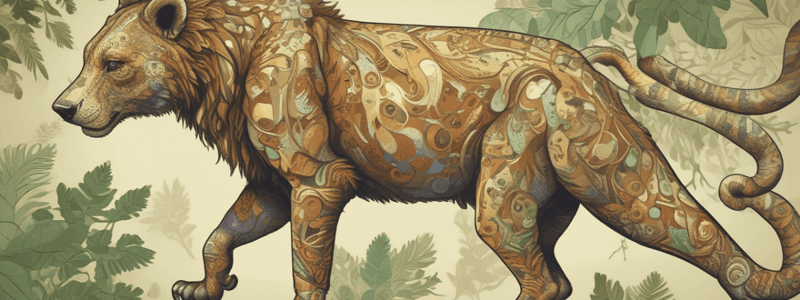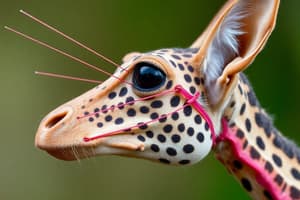Podcast
Questions and Answers
What is the primary reason why Armillaria can become the largest known living organism on earth?
What is the primary reason why Armillaria can become the largest known living organism on earth?
- It has a highly complex nervous system
- It has a unique adaptation that allows it to survive for over 1500 years (correct)
- It is a highly social organism
- It has a highly developed sense of smell
What is the function of the second touch required to trigger the Venus flytrap's snapping shut?
What is the function of the second touch required to trigger the Venus flytrap's snapping shut?
- To attract more insects
- To conserve energy
- To detect the presence of insects
- To avoid false alarms and catch only nutritious prey (correct)
What is an example of an adaptation that extends beyond the body of the individual with the adaptation?
What is an example of an adaptation that extends beyond the body of the individual with the adaptation?
- A bird's nest
- A spider's web
- A beaver's dam
- All of the above (correct)
What is the purpose of the peacock's tail, despite being cumbersome and not ideal for camouflage?
What is the purpose of the peacock's tail, despite being cumbersome and not ideal for camouflage?
How do we know that the waggle dance of honeybees is an adaptation?
How do we know that the waggle dance of honeybees is an adaptation?
What is an example of a preadaptation?
What is an example of a preadaptation?
What is pleiotrophy?
What is pleiotrophy?
What is the term for when a feature is present because it gives a selective advantage?
What is the term for when a feature is present because it gives a selective advantage?
What is an example of an adaptation that helps the organism to breed, rather than survive?
What is an example of an adaptation that helps the organism to breed, rather than survive?
What is the term for the study of the history of a species or trait to determine if it is an adaptation?
What is the term for the study of the history of a species or trait to determine if it is an adaptation?
What is the primary function of active camouflage in crab spiders?
What is the primary function of active camouflage in crab spiders?
What is the function of topoisomerase 2 enzyme in cells?
What is the function of topoisomerase 2 enzyme in cells?
What is the unique feature of the giant redwood's xylem capillaries?
What is the unique feature of the giant redwood's xylem capillaries?
How do Venus flytraps avoid false alarms?
How do Venus flytraps avoid false alarms?
What is the purpose of the peacock's tail?
What is the purpose of the peacock's tail?
What is the function of the waggle dance in honeybees?
What is the function of the waggle dance in honeybees?
How can we be sure that a trait is an adaptation?
How can we be sure that a trait is an adaptation?
What is a characteristic of Armillaria, also known as honey fungus?
What is a characteristic of Armillaria, also known as honey fungus?
What is an example of an adaptation that extends beyond the body of the individual?
What is an example of an adaptation that extends beyond the body of the individual?
What is the purpose of the trematode parasite's adaptation?
What is the purpose of the trematode parasite's adaptation?
What is the primary reason why an adaptation is present in an organism?
What is the primary reason why an adaptation is present in an organism?
What is the main purpose of active camouflage in crab spiders?
What is the main purpose of active camouflage in crab spiders?
At which spatial scales do adaptations appear?
At which spatial scales do adaptations appear?
What is the function of topoisomerase 2?
What is the function of topoisomerase 2?
How do the enzymes like topoisomerase 2 prevent DNA from becoming tangled?
How do the enzymes like topoisomerase 2 prevent DNA from becoming tangled?
How much water can the xylem capillaries of a giant redwood lift per day?
How much water can the xylem capillaries of a giant redwood lift per day?
What allows honey fungus Armillaria clones to communicate and fuse?
What allows honey fungus Armillaria clones to communicate and fuse?
What is the primary characteristic of an adaptation?
What is the primary characteristic of an adaptation?
What is the function of active camouflage in chameleons?
What is the function of active camouflage in chameleons?
How long does it take for crab spiders to change color?
How long does it take for crab spiders to change color?
What is the significance of measuring the rate of evolution in a sequence?
What is the significance of measuring the rate of evolution in a sequence?
Why is it important to be cautious when labeling a trait as an adaptation?
Why is it important to be cautious when labeling a trait as an adaptation?
What is an example of a cultural adaptation in animals?
What is an example of a cultural adaptation in animals?
What is the term for a feature that evolved for one purpose but proves useful for another?
What is the term for a feature that evolved for one purpose but proves useful for another?
What is a characteristic often correlated with domestication in mammals, but not an adaptation?
What is a characteristic often correlated with domestication in mammals, but not an adaptation?
What is the term for a gene that has multiple effects?
What is the term for a gene that has multiple effects?
Why is the kea's strong beak not an adaptation for attacking sheep?
Why is the kea's strong beak not an adaptation for attacking sheep?
What is the significance of genetic uniformity in humans?
What is the significance of genetic uniformity in humans?
What is the main difference between an adaptation and a mutation?
What is the main difference between an adaptation and a mutation?
What is an example of a preadaptation in animals?
What is an example of a preadaptation in animals?
Study Notes
Adaptations
- An adaptation is a feature of an organism that provides a selective advantage, and its presence is due to the advantage it gives.
- Biologists may have different definitions of adaptation, but it is a key concept in understanding the evolution of life.
Types of Adaptations
- Morphological adaptations: e.g. camouflage, changes in body shape or structure that aid survival.
- Active camouflage: ability to change colour to match surroundings, found in cephalopods, fish, lizards, and crab spiders.
- Behavioural adaptations: e.g. Venus Flytrap's trap-like leaves, social behaviours like communication and cooperation.
- Adaptations can extend beyond the individual's body, e.g. a bird's nest, a spider's web, or a beaver's dam.
Examples of Adaptations
- Topoisomerase 2: an enzyme that detangles DNA, preventing it from becoming tangled and unusable during DNA replication.
- Giant redwood's network of xylem capillaries: lifts around a ton of water a day 115 metres up the tree to the leaves.
- Honey fungus Armillaria's genetic fingerprinting system: allows clones to communicate and fuse to form a single individual organism, making it the largest known living organism on earth.
Detecting Adaptations
- Experiments and observations can help determine if a trait is an adaptation.
- The comparative method: comparing many species to judge whether a feature is an adaptation, taking into account history.
- Measuring the speed of evolution: very slow or very fast evolution, relative to the mutation rate, indicates a well-adapted or currently adapting sequence.
- Within-species adaptations: humans have some examples of adaptations, such as lactase persistence in adults.
Considerations
- Culture/learned behaviour: must be careful when calling something an adaptation, as it may be learned rather than encoded in genes.
- Preadaptation: a feature that evolved for one purpose but proves handy for another, e.g. the kea's beak.
- Pleiotrophy: when a gene has more than one effect, e.g. a domesticated fox's colour pattern correlated with sociability towards humans.
Studying That Suits You
Use AI to generate personalized quizzes and flashcards to suit your learning preferences.
Description
Learn about adaptations, their role in giving selective advantage, and explore examples of active camouflage in various animal groups, including cephalopods, fish, lizards, and chameleons.




